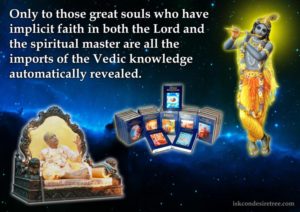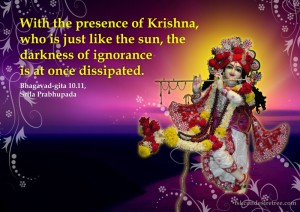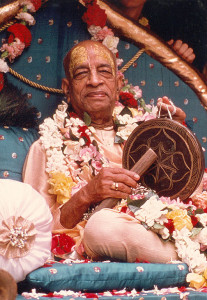Hare Krishna dear devotees,
I read verse 4.42 from Bhagavad Gita today morning and its amazing purport where Srila Prabhupada not only gives us the summary of the whole chapter 4 but also gives us many keys to open different levels of transcendental knowledge. The chapter itself is titled transcendental knowledge. I am sharing the same. Please chew it slowly.
tasmäd ajïäna-sambhütaà håt-sthaà jïänäsinätmanaù
chittvainaà saàçayaà yogam ätiñöhottiñöha bhärata
TRANSLATION
Therefore the doubts which have arisen in your heart out of ignorance should be slashed by the weapon of knowledge. Armed with yoga, O Bharata, stand and fight.
(BG 4.42)
PURPORT
The yoga system instructed in this chapter is called sanätana-yoga, or eternal activities performed by the living entity. This yoga has two divisions of sacrificial actions: one is called sacrifice of one’s material possessions, and the other is called knowledge of self, which is pure spiritual activity. If sacrifice of one’s material possessions is not dovetailed for spiritual realization, then such sacrifice becomes material. But one who performs such sacrifices with a spiritual objective, or in devotional service, makes a perfect sacrifice. When we come to spiritual activities, we find that these are also divided into two: namely, understanding of one’s own self (or one’s constitutional position), and the truth regarding the Supreme Personality of Godhead. One who follows the path of Bhagavad-gétä as it is can very easily understand these two important divisions of spiritual knowledge. For him there is no difficulty in obtaining perfect knowledge of the self as part and parcel of the Lord. And such understanding is beneficial, for such a person can easily understand the transcendental activities of the Lord. In the beginning of this chapter, the transcendental activities of the Lord were discussed by the Supreme Lord Himself. One who does not understand the instructions of the Gétä is faithless, and is to be considered to be misusing the fragmental independence awarded to him by the Lord. In spite of such instructions, one who does not understand the real nature of the Lord as the eternal, blissful, all-knowing Personality of Godhead is certainly fool number one. Ignorance can be removed by gradual acceptance of the principles of Kåñëa consciousness. Kåñëa consciousness is awakened by different types of sacrifices to the demigods, sacrifice to Brahman, sacrifice in celibacy, in household life, in controlling the senses, in practicing mystic yoga, in penance, in forgoing material possessions, in studying the Vedas, and in partaking of the social institution called varëäçrama-dharma. All of these are known as sacrifice, and all of them are based on regulated action. But within all these activities, the important factor is self-realization. One who seeks that objective is the real student of Bhagavad-gétä, but one who doubts the authority of Kåñëa falls back. One is therefore advised to study Bhagavad-gétä, or any other scripture, under a bona fide spiritual master, with service and surrender. A bona fide spiritual master is in the disciplic succession from time eternal, and he does not deviate at all from the instructions of the Supreme Lord as they were imparted millions of years ago to the sun-god, from whom the instructions of Bhagavad-gétä have come down to the earthly kingdom. One should, therefore, follow the path of Bhagavad-gétä as it is expressed in the Gétä itself and beware of self-interested people after personal aggrandizement who deviate others from the actual path. The Lord is definitely the supreme person, and His activities are transcendental. One who understands this is a liberated person from the very beginning of his study of Bhagavad-gétä.
This is a gem of a purport and is so potent that one can achieve liberation simply by carefully studying and applying its essence.
HG Bhurijana Prabhu divides this purport into five sections in his book Surrender unto me. Inspired from those titles I am adding little comments.
- The Goal of sacrifice (Part 1)
Sacrifices themselves are not the goal. They are means to achieve a goal. The same sacrifice could result in a material or spiritual goal depending simply on the consciousness with which we are doing it.
Today is Ekadasi. Many people in India keep Ekadasi fast, some out of family tradition, some have heard or read about the unlimited piety it brings but devotees keep it simply to please Krishna. So the same sacrifice will culminate in different results for the different people though the act of sacrifice is apparently the same. So our purpose should always be spiritual. Srila Prabhupada writes
One who performs such sacrifices with a spiritual objective, or in devotional service, makes a perfect sacrifice.
2. Two levels of spiritual knowledge
a) understanding of one’s own self (or one’s constitutional position), and
b) the truth regarding the Supreme Personality of Godhead.
Srila Prabhupada gives the synopsis of this transcendental knowledge in his purport of BG 4.35
For want of sufficient knowledge in the absolute science, we are now covered with illusion, and therefore we think that we are separate from Kṛṣṇa. Although we are separated parts of Kṛṣṇa, we are nevertheless not different from Him. The bodily difference of the living entities is māyā, or not actual fact. We are all meant to satisfy Kṛṣṇa. By māyā alone Arjuna thought that the temporary bodily relationship with his kinsmen was more important than his eternal spiritual relationship with Kṛṣṇa. The whole teaching of the Gītā is targeted toward this end: that a living being, as Kṛṣṇa’s eternal servitor, cannot be separated from Kṛṣṇa, and his sense of being an identity apart from Kṛṣṇa is called māyā. The living entities, as separate parts and parcels of the Supreme, have a purpose to fulfill. Having forgotten that purpose since time immemorial, they are situated in different bodies, as men, animals, demigods, etc. Such bodily differences arise from forgetfulness of the transcendental service of the Lord. But when one is engaged in transcendental service through Kṛṣṇa consciousness, one becomes at once liberated from this illusion.
3. Transcendental nature of Supreme Lord
In the beginning verses of this chapter Krishna spoke how He first gave this transcendental knowledge to sun-god, Vivasvān, millions of years ago and it was being passed down via parampara but then it got lost. And how Krishna, unlike Arjuna, remembers all His previous births. Then Krishna declares in BG 4.6
Although I am unborn and My transcendental body never deteriorates, and although I am the Lord of all living entities, I still appear in every millennium in My original transcendental form.
Srila Prabhupada writes in his purport
In spite of such instructions, one who does not understand the real nature of the Lord as the eternal, blissful, all-knowing Personality of Godhead is certainly fool number one.
4. The Goal of sacrifice (part 2)
They are so many different kinds of sacrifices mentioned in vedas and , Srila Prabhupada, writes
All of them are based on regulated action. But within all these activities, the important factor is self-realization. One who seeks that objective is the real student of Bhagavad-Gita.
Even big big jnanis and yogis, what to speak of normal people, get bewildered as to what exactly self realisation means. Actual self realisation means God realisation. They may sound different but are firmly inter-linked.
Self realization means God realization, and God realization means self realization. Just like to see the sun means to see oneself, and to see oneself means to see the sun. Self realization depends completely upon God realization, or else it is not complete. One must know his relationship to the Absolute Truth to fully know his position. The mayavadi school simply discerns spirit from matter, but that is not Ultimate Knowledge. One should know the different manifestations of the spirit also. The highest manifestation of the spirit soul is the Supreme Personality of Godhead, Lord Krishna.
(letter to Vilasavigraha Prabhu, 22nd Jan 1969)
5. Properly learning transcendental knowledge
One should learn this knowledge from a bonafide spiritual master coming in the authorised line of disciplic succession. Krishna says in BG 4.2
This supreme science was thus received through the chain of disciplic succession, and the saintly kings understood it in that way. But in course of time the succession was broken, and therefore the science as it is appears to be lost.
Arjuna, Krishna’s friend & devotee, also an eternal associate of Krishna, become an instrument to give this knowledge to the whole world. Similarly Srila Prabhupada, not only a great devotee of Lord Krishna and one of the greatest acharayas in last hundred years, coming in the line of exalted Gaudia vaishanavas, also an eternal associate of Krishna, became an instrument to spread this transcendental knowledge worldwide.
Why it is so important to hear this from a bonafide spiritual master?
Srila Prabhupada writes
he does not deviate at all from the instructions of the Supreme Lord as they were imparted
So the message is passed on ‘as it is’ without any deviation or personal interpretation. That’s why ISKCON’S version of Bhagavad Gita is called Bhagavad Gita As it is.
And what will be the result of following all the above points sincerely?
Srila Prabhupada writes at the end of his purport
One who understands this is a liberated person from the very beginning of his study of Bhagavad-gītā.
It is simply our good fortune that we have somehow taken shelter of Srila Prabhupada’s lotus feet and are trying to become Krishna consciousness. Where else can one read a verse from one of the begining chapters of Bhagavad and not only get the summary of the whole chapter but if one applies it with proper faith then one can get liberation at this stage itself! This is the potency of reading Bhaktivedanta purports.
I feel unqualified to understand, receive or apply this knowledge!
The qualification required to unlock the wealth in Prabhupada’s purports is simply our faith, sincerity and seriousness to become Krishna consciousness. That’s all, not how much knowledge I have or how much austerity I can perform or even my lifestyle before coming in touch with the devotees. None of this matters. What matters is how sincerely I desire and wish to change now. Our past is not a hindrance.
How?
We all know that when bed sheets gets spoiled and strained ( say sheet used by small babies on which they have passed urine etc.). These strains on the sheets doesn’t go despite all the washing and scrubbing. But an experienced and intelligent mother knows that by hanging these sheets daily in the bright sun not only the sheet get germ free but they will also gradually becomes strain free. Similarly when we come in touch with this transcendental knowledge then not only our past karmic reactions are gone but gradually our consciousness starts becoming pure and we can make rapid progress in self realisation despite what all may have been our past life (or lives).
This is the potency and the result of regularly, and carefully, studying Srila Prabhupada’s books. Everything will get gradually revealed in our heart by his mercy and potency. This is our simple, proven and bonafide process for receiving all transcendental knowledge.
All glories to Sri Guru and Gauranga.
All glories to Srila Prabhupada.
your servant,
Giriraj dasa




